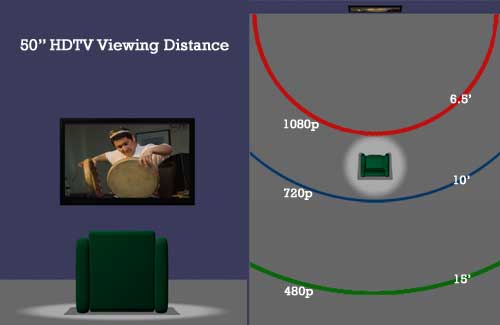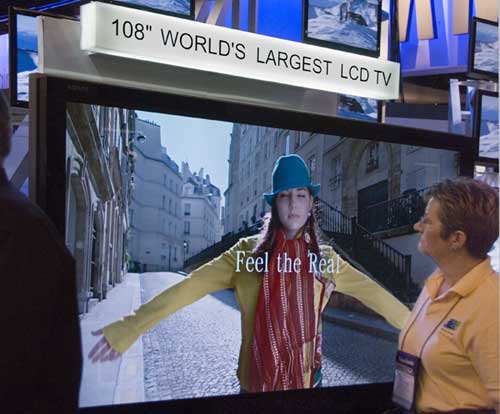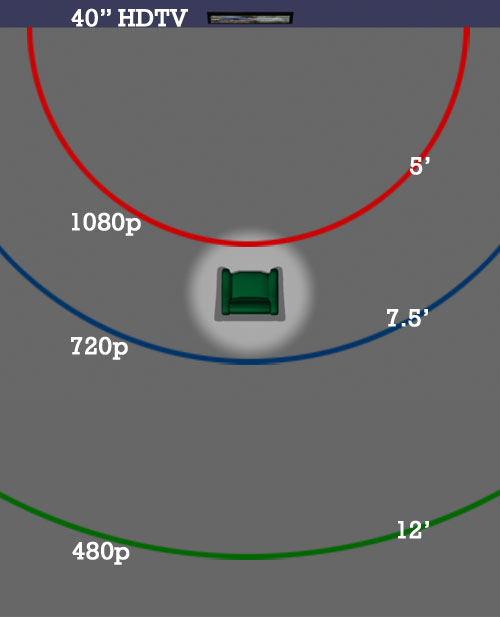
|
|
 |

|


Dick De Jong April 28, 2007 HDTV Solutions We received an email from a reader a while back. (We'll call him Rick since that's his name.) Rick is designing his new home theater room and he had a simple inquiry: if he is planning to sit 11 feet from his HDTV, should he buy a 50" 1080p plasma or spend a comparable amount on a 55 or 60" 720p plasma? It's a great practical question. Since 1080p plasmas still cost quite a bit more than the 720p models, can you tell the difference in picture quality? And if so, how close to the TV do you have to sit to see it? In Rick's situation, since he has already decided on the seating distance, will his family be able to discern a 720p from a 1080p at 11 feet away? The flip side of that situation is that you just bought a 50" 1080p TV. In neighborly one-upmanship terms, the question might be rephrased as, "Where do I need to place the chair so my _____ (neighbor, boss, father-in-law, wife?) can fully appreciate my fancy high definition TV?"
If you have been reading any of my reviews, you will know that I think picture quality is based on a number of characteristics. Everyone has their own priority list. For me, consistent skin tones ranks much higher than resolution. But in Rick's case, we assume all things are equal in the TVs that he is considering except for resolution and screen size. If so, then we can deal with more quantifiable and less subjective factors. First is clarity. Think of trying to read the last line of an eye chart in a doctor's office. The British Broadcasting Corporation (BBC) developed their own TV eye test, (based on resolving arcminutes and other arcane math that you don't need to know.) Their formulas tell you at what distance you will see a difference in screen resolution, which addresses Rick's question directly. Before I give you the numbers, let's reestablish a fundamental tenet of all these screen resolutions – the more pixels, the better the detail. In Rick's case, he is looking at a 50" HDTV. A native 720p TV, (1280 pixels wide by 720 pixels high), will not display as detailed an image as a native 1080p TV (1920 pixels wide by 1080 pixels high). And of course, pulling up the rear, an old standard definition TV at 720 x 480 resolution would have the least amount of detail. Now, if you think about it, if you are sitting too far away – let's say about 30 feet – your poor eyes, even if they are 20-20, won't be able to discern the difference in the sharpness between the old duffer standard def TV, (assuming you could ever find a 50" standard def TV), and your brand spanking sleek and sexy 720p HDTV.
If you have a gawd-almighty gaudy 1080p TV next to the 720p one, you are going to have to walk even closer to reach that "definitely I can see the difference" distance. The charts say for a 50" display, you need to cozy up to 6.5 feet from the TV to clearly tell a 1080p from a 720p. (For a more detailed explanation of the charts, see Which One is Sharper, #1 or #2? below.) So what does this mean for Rick? If he is sitting 11 feet away from a 50" TV, he will not be able to notice the difference in sharpness between a native 720p display and a 1080p display. So if detail is a deciding factor, he could save some money and buy the 50" 720p or buy a larger 720p TV for the same price as a 50" 1080p. Though if he is considering 60" TVs, then his 11 foot viewing distance starts to fall in the "I think I can see a difference" between a 720p and 1080p display.
Simply, the bigger the TV, the farther away you can stand and notice the difference. For example, if Rick won the lottery and decided to supersize to one of those new 108" my HDTV is bigger than yours, then standing at about 13 feet away he would definitely see 1080p over 720p. Actually, all the new room-filling 70" and larger HDTVs are only coming in the 1080p flavor, partially because of this clarity issue.
Now, the mathematical formulas answers Rick's question. But optimum viewing distance is not always determined by eye chart factors like clarity or detail. Where you feel comfortable sitting is much more idiosyncratic. Just walk into a half empty megaplex movie theater and notice how spread out the audience is. Everyone seems to have a different comfort zone. For example, around here, we fall into the immersive experience camp. We love to fill our visual field with the image or in other words, we like to sit close to the screen. And quite conveniently, there is a guideline that justifies our propensity for proximity. THX, the folks famous for certifying movie theaters, explain their guiding principles for the home theater picture with the phrase, "Big enough to fill your vision, but small enough to be clear and sharp." The THX guys are basing their seating distance calculations on trying to maintain a 40 degrees viewing angle. In our reviews of HDTVs we have used the term "viewing angle" to denote how far off center that you can sit and still see an image that is not washed out. In this case with THX, we are talking about your vision's angle, which is different. If you are sitting in the green chair and look straight ahead, THX suggests that the HDTV be placed at a distance where the image occupies 40 degrees of your vision The formula to achieve that is Screen Width / .73 or more simply Screen Width x 1.37. For Rick and his 50" TV, he should sit no farther back than 5' 8.5" (50 x 1.37 = about 68.5"), which is definitely in the "I can see the 1080p difference" range.
Of course, if you are the back of the theater type, then SMPTE (Society of Motion Pictures and Television Engineers) has a guideline more attuned to your eyes. Their optimum viewing angle is 30 degrees, which figures out to be about Screen Width x 2. For that 50" HDTV, we're talking a little over 8' back. The viewing distance for a 37" TV would be about 6'.
Now if all these distances still seem a little too close for comfort, then maybe you grew up with the old (SD) TV guidelines, which suggested that you sit 3 and even 4 times screen width away. Way back when, a big TV was 19" and if you sat too close to it, you could see the scan lines. And if the whole family huddled around the set, there would be no room for the TV trays holding the TV dinners. With all these charts and formulas, remember we are talking about two different things. The first issue was Rick's question, how close do you have to sit before you will notice the difference between a 720p display and a 1080p? The answer is calculated objectively according to visual acuity criteria. The second question, how close should I sit to the TV, has a much more subjective answer. You can look at the THX or SMPTE guidelines, but ultimately it is a matter of personal preference. We're starting the DVD. Pull up a chair. Which One is Sharper, #1 or #2? To explain the viewing distance charts, let's sit you in that plushy green chair. To give you the lay of the land, in this diagram, a 40" HDTV is at the top. The green chair is facing it about 6' away. And, by the way, we're assuming that your eyesight is 20/20.
Now imagine that there were three TVs up there. One had a standard definition resolution of 480, the second 720 and the third 1080. If you pushed the chair back behind the green line and sat down, you couldn't tell the difference in detail between the three because you are too far back to see it. If you shoved the chair between the green line and the blue line, then you will begin to notice the 480 TV doesn't look so hot next to the 720 and 1080. At the blue line, 7.5', it's clear that the 720 and the 1080 show more detail than the 480. But the difference between the 720 and 1080 doesn't really begin to appear until you place the chair in between the blue line and red line. Finally, if you plop down in the chair set at the red line, (5' in this case with a 40" HDTV), you will say, "Eureka! This is why I bought that 1080p TV." At the red line and closer, the better detail of the 1080p over the 720p will be apparent. |
Bookmark:
![]() del.icio.us
del.icio.us
![]() Reddit
Reddit
![]() Google
Google
Reader Comments
Posted Oct 13, 2009 4:35:54 AM |
|
By Lisa |
|
Posted Sep 3, 2009 3:44:14 AM |
|
By Hotdog Neck |
|
Posted Jul 20, 2009 3:49:38 PM |
|
By A. Bennett |
|
Posted Oct 9, 2008 12:10:20 AM |
|
By Dick De Jong |
|
"How can I determine how high up I can hang a TV? Is there a formula for that?"
The other goes:
"What is the optimal height for comfortable viewing?"
My answer is that the distance that I talked about in the article still applies. The one added factor is angle.
For example, if you mount the TV above a fireplace - say seven feet off the ground - then you should angle the top of the TV away from the wall and towards where you will be sitting. Some articulating TV mounts are made to do just that.
Basically, the ideal viewing angle is for the TV screen to be perpendicular to your eyes. If you keep to that formula then you negate the washed out effect of sitting off angle. This is especially true with LCDs.
As for comfort, even if you angle the TV towards your eyes, you still have to tilt your head up to see the TV. For me, the less I have to crane my neck, the more comfortable I am. That is why I am not a big believer in mounting your TV too high.
If I am sitting in a chair or couch, ideally for me, the bottom of the TV is not any higher than my eye level. It should be easy enough for you to tape a spot on the wall where the center of the TV will hang and then sit in your favorite viewing chair and see if you will be comfortable watching a two hour movie.
Let me know if you have other questions.
Posted Sep 24, 2008 9:21:15 AM |
|
By Dick De Jong |
|
You are correct in assuming that if you sit 8 to 10 feet away from a 37" TV that you will not notice the difference in resolution between a 1080p and a 720p TV.
Enjoy the bargain you can get by buying a 720p TV.
Posted Sep 23, 2008 8:57:22 PM |
|
By Maggie |
|
Posted Apr 29, 2008 5:48:54 AM |
|
By KD_KD_KD |
|
I derived the formula below based on the 3 examples in the article (40, 50 and 60 inch). The common factor of 135 actually varied between 135 and 144, due (I assume) to rounding up to full or half feet in the source numbers, so just use a number in the above range (noting that a smaller value gives a more conservative estimate).
In theory, and if I read the article correctly, this should give you the minimum distance you need to be from the display to appreciate the resolution (any further away and you could consider a lower res).
Distance (feet) = Size (inches) * 135 / Lines of Resolution
e.g. for a 37" display
D=37*135/1080= about 4.5 feet
I've checked this for my own purposes, but would appreciate someone rechecking the calcs, and reposting if you find that I am incorrect.
Posted Oct 19, 2007 4:16:41 PM |
|
By LEWBOB |
|
Posted Jul 8, 2007 6:44:42 PM |
|
By PaulH |
|
I own and operate a small growing installation company and am always looking to improve the skills and service offered to my clients. Can you detail more information about your calculations i.e. how are they derived.
If I have not offended you with the request, I would like to build my own calculator as a tool to help in specifying screen size/resolution for clients.
Regards, Paul Horwood
Posted May 8, 2007 1:11:50 AM |
|
By GrayingMatter |
|
I intend to write more articles about design that will hopefully add to this one and present a more holistic view that will include audio.
Thanks,
Dick De Jong Editor
Posted May 3, 2007 11:08:02 AM |
|
By westcott |
|
What I think many people forget about is the other half of the equation which is audio. It has its own recommendations for seating distances from the front wall and proximity to the back wall. It also has guidelines for seating orientation, based on room dimensions. So many times I see systems set up any which way with audio taking a back seat to asthetics and display position.
I would like to see a more holistic approach taken so that one can acquire, or at least consider, the two parts of what makes a great home theater experience.
| Send this Page | Print this Page | Report Errors |











Posted Mar 20, 2010 3:37:51 AM
By WAYNET